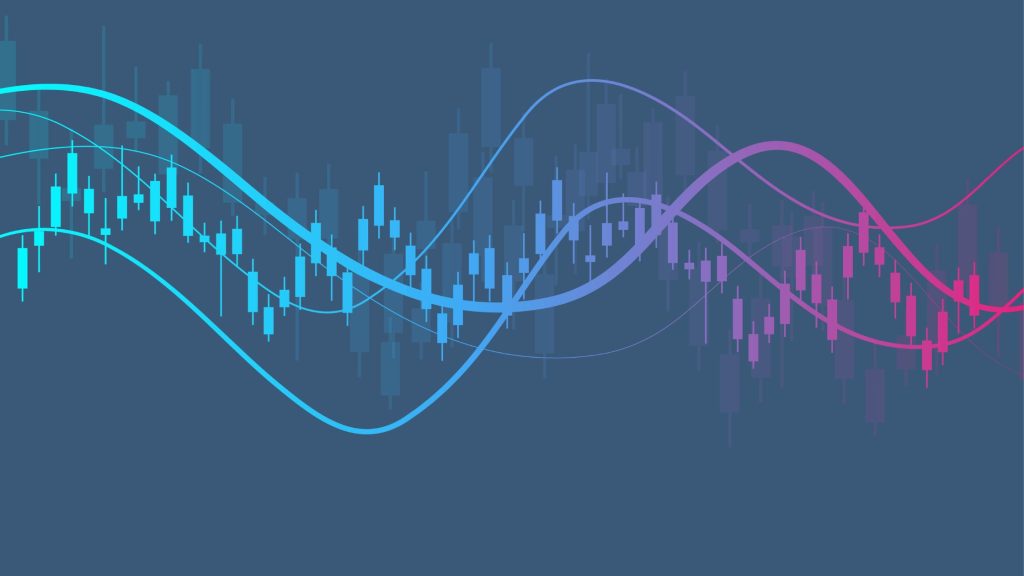Trend trading in forex refers to a trading strategy where a trader buys or sells a currency pair based on the direction of the current trend. The goal of trend trading is to identify the current trend, and then enter trades that align with that trend.
There are three main types of trends in forex trading: uptrend, downtrend, and sideways trend. An uptrend is characterized by higher highs and higher lows, a downtrend is characterized by lower highs and lower lows, and a sideways trend is characterized by a range-bound market with no clear direction.
Identifying Trends in the Forex Market
To identify the trend, traders use various technical indicators and chart patterns, such as moving averages, trendlines, and chart patterns.
There are several ways to identify a trend in forex, but some of the most popular methods include:
- Moving averages: One of the most popular ways to identify a trend is by using moving averages. A simple moving average (SMA) can be used to smooth out price action and identify the direction of the trend. When the moving average is going up, it indicates an uptrend. When the moving average is going down, it indicates a downtrend.
- Trendlines: Another way to identify a trend is by drawing trendlines. A trendline is a straight line that connects two or more price points and is extended into the future to identify the direction of the trend. A trendline that is angled up indicates an uptrend, while a trendline that is angled down indicates a downtrend.
- Relative strength index (RSI): This is a momentum oscillator that compares the magnitude of recent gains to recent losses, it is used to determine overbought and oversold conditions of an asset. When the RSI is above 70, it is considered overbought, indicating a potential trend reversal to the downside. Conversely, when the RSI is below 30, it is considered oversold, indicating a potential trend reversal to the upside.
- Moving Average Convergence Divergence (MACD): This is another popular trend-following indicator, it uses the difference between two moving averages to identify the direction of the trend. When the MACD line is above the signal line, it indicates an uptrend. When the MACD line is below the signal line, it indicates a downtrend.
- Ichimoku Kinko Hyo: This is a trend-following indicator that uses multiple moving averages to identify the direction of the trend. The “cloud” formed by the Ichimoku indicator can be used to identify the direction of the trend, with the top of the cloud indicating resistance and the bottom of the cloud indicating support.
Keep in mind that different traders may prefer different methods for identifying trends, and that it’s important to use multiple methods to confirm a trend before making a trade.

Tips for Successfully Implementing Trend Trading in Your
Forex Trading Strategy in 2023
Once the trend is identified, traders can enter trades in the direction of the trend using a variety of different strategies, such as:
- Buying on pullbacks: This strategy involves buying when the currency pair retraces against the trend, but remains above the key support levels.
- Selling on rallies: This strategy involves selling when the currency pair rallies against the trend, but remains below key resistance levels.
- Trailing stop-loss: This strategy involves using a stop-loss order that is placed at a certain distance from the current market price, and is moved up or down as the market price moves in the trader’s favor.
It’s worth noting that trend trading is a popular strategy among traders, but it can be risky. When the trend is not clear or the market is in a consolidation phase, traders may have to wait for the trend to be confirmed or change their strategy.
Here is an example of how to trade a trend in forex using a buying pullbacks strategy:
- Identify the trend: First, you will need to identify the trend by looking at the chart of the currency pair you want to trade. In this example, we will use the EUR/USD currency pair. Using a moving average indicator, you notice that the 50-day moving average is above the 200-day moving average, indicating an uptrend.
- Identify pullbacks: Once you have identified the uptrend, you will need to watch for pullbacks, which are small retracements against the trend. You can use trendlines, moving averages, or Fibonacci retracement levels to identify key levels of support where the price may find buying interest.
- Place a buy order: Once you have identified a pullback, you can place a buy order at the key level of support. You can also set a stop-loss order below the key level of support to limit your potential loss.
- Exit the trade: After entering the trade, you will need to monitor the price action and the key levels of support and resistance to determine when to exit the trade. One strategy would be to exit the trade when the price breaks above a key level of resistance, indicating a potential change in trend.
- Take profit: Another strategy would be to set a take-profit order at a key level of resistance, such as a previous high or a Fibonacci retracement level. Alternatively, you can also use a trailing stop-loss order to lock in profits as the price moves in your favor.
It’s worth noting that the buying pullbacks strategy can be a great way to enter a trade with a good risk-reward ratio, but it’s important to wait for a confirmation of the market trends before entering the trade.
Here is an example of a trend reversal trade in forex:
- Identify the trend: First, you will need to identify the trend by looking at the chart of the currency pair you want to trade. In this example, we will use the EUR/USD currency pair. Using a moving average indicator, you notice that the 50-day moving average is above the 200-day moving average, indicating an uptrend.
- Identify reversal signals: Once you have identified the uptrend, you will need to watch for reversal signals, such as bearish candlestick patterns, divergence on oscillators such as RSI, or a break below trendline or key levels of support.
- Place a short order: Once you have identified a reversal signal, you can place a short (sell) order at the current market price. You can also set a stop-loss order above the key level of resistance to limit your potential loss.
- Exit the trade: After entering the trade, you will need to monitor the price action and the key levels of support and resistance to determine when to exit the trade. One strategy would be to exit the trade when the price breaks above a key level of resistance, indicating a potential change in trend or when a bullish candlestick pattern occurs.
- Take profit: Another strategy would be to set a take-profit order at a key level of support, such as a previous low or a Fibonacci retracement level. Alternatively, you can also use a trailing stop-loss order to lock in profits as the price moves in your favor.
Trend reversal trades can be risky and it’s important to wait for a confirmation of the reversal before entering the trade.

Managing Risk in Trend Trading
There are several ways to manage risk while trend trading in forex:
- Use stop-loss orders: These are orders that automatically exit a trade when the market moves against you by a certain amount. This helps to limit your potential losses.
- Use take-profit orders: These are orders that automatically exit a trade when the market moves in your favor by a certain amount. This helps to lock in profits.
- Use proper position sizing: This means not risking too much of your account on any one trade. A general rule of thumb is to risk no more than 2% of your account on any one trade.
- Use risk/reward ratios: This means setting your take-profit level at a multiple of your stop-loss level. A common ratio is 1:3, meaning you aim to make three times as much on your winning trades as you risk on your losing trades.
- Have a plan and stick to it: It is important to have a clear plan for managing risk, and to stick to it even when things are going well or poorly.
- Diversify: It is important to diversify your portfolio and not put all your eggs in one basket, it will reduce the risk of losing all your funds.
Ultimately, the key to successful risk management in forex trading is to have a well-defined plan and to stick to it.




